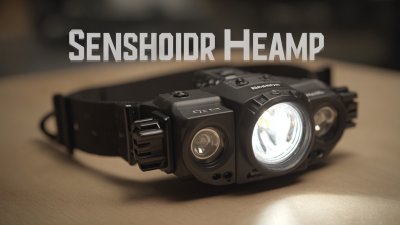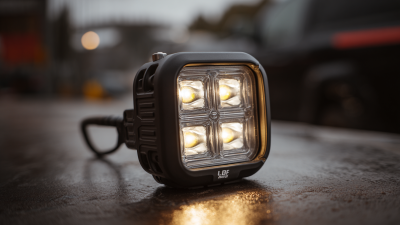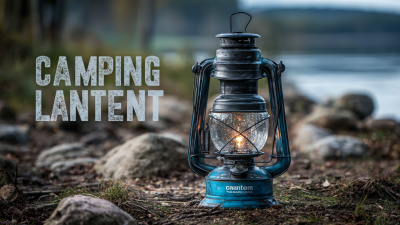How to Choose the Best Hard Hat Headlamp for Optimal Safety and Performance
In the demanding environments of construction, mining, and industrial work, safety is paramount, and effective lighting is a crucial component of that safety. The use of a Hard Hat Headlamp not only enhances visibility in low-light situations but also significantly reduces the risk of accidents. According to a report by the Bureau of Labor Statistics, over 20% of construction site injuries occur due to falls, often exacerbated by insufficient lighting. Moreover, the American National Standards Institute (ANSI) emphasizes the importance of proper head protection and illumination to maximize worker safety and performance. Selecting the right Hard Hat Headlamp can make a substantial difference in a worker's ability to navigate hazardous environments effectively, ensuring both personal safety and enhanced productivity. In this guide, we will explore the key factors to consider when choosing the optimal Hard Hat Headlamp for your specific needs, aiming for superior safety and performance in the field.

Factors to Consider When Selecting a Hard Hat Headlamp for Industrial Applications
When selecting a hard hat headlamp for industrial applications, there are several crucial factors to consider to ensure optimal safety and performance. Firstly, the brightness of the headlamp is essential; look for models that offer adjustable brightness settings to accommodate various working conditions. A lumens rating of at least 200 is recommended for industrial settings, as it provides adequate visibility in low-light environments. Additionally, consider the beam distance and pattern—wide beams are ideal for close-up tasks, while focused beams help illuminate distant areas.
Durability is another key factor. Industrial environments can be harsh, so choose a headlamp constructed from rugged materials that are resistant to impacts and water. Look for features like an IP rating to ensure protection against dust and water ingress. Battery life also plays a significant role; a longer run time means less frequent recharging or battery replacement during work shifts. Finally, comfort and fit are vital for extended use; select a headlamp with an adjustable and breathable headband to ensure it stays securely in place while allowing for ventilation.
Understanding Lumens and Lux: The Key to Brightness and Beam Distance in Headlamps
When selecting a headlamp, understanding lumens and lux becomes essential for ensuring optimal brightness and beam distance. Lumens measure the total light output from a source, while lux indicates how concentrated that light is over a specific area. For tasks requiring detailed visibility, such as construction work or outdoor activities, a headlamp that provides high lumens can illuminate a wide area effectively. However, it's also crucial to consider lux values, as they determine how well the light can penetrate darkness at distance—this combination is often overlooked in marketing claims, which can be misleading.
Recent reviews highlight that many products exaggerate their maximum beam distance and battery run-time, potentially leading consumers to make misinformed choices. For instance, while some headlamps boast impressive lumens, they may not deliver adequate lux for practical use, especially in demanding environments. The importance of a balanced output cannot be overstated; headlamps that strike the right balance between brightness and run-time, ideally rated between 200 to 600 lumens for general use, provide the safety and performance necessary for effectiveness in real-world scenarios.
Assessing Battery Life: How Long Should Your Hard Hat Headlamp Last on the Job?
When selecting a hard hat headlamp, one of the most critical factors to consider is battery life. A reliable headlamp should provide consistent illumination over extended periods, which is essential for ensuring safety and performance on the job. Workers often face demanding conditions where access to power sources is limited. Therefore, investing in a headlamp designed with high-capacity batteries can prevent interruptions and allow for uninterrupted workflow.
Consider the type of tasks you will be performing when assessing battery life. Some projects may require long-range illumination, while others may need a broader field of view. Look for headlamps that offer multiple brightness settings, as they can adapt to various situations and conserve battery when full power isn’t necessary. A hard hat headlamp with a runtime of at least 8-12 hours on the highest setting is generally recommended to meet the needs of most professions. Always remember to check for additional features like rechargeable batteries, which can save money and resources in the long run, enhancing both sustainability and reliability on the job site.
The Importance of ANSI/ISEA Standards in Hard Hat Headlamp Safety Compliance
 When selecting a hard hat headlamp, one critical aspect to consider is compliance with ANSI/ISEA standards. These standards ensure that the headlamps are rigorously tested for safety, performance, and durability, making them suitable for various working environments. ANSI (American National Standards Institute) and ISEA (International Safety Equipment Association) provide guidelines that manufacturers must follow, which helps ensure that the hard hats and their corresponding headlamps offer adequate protection against potential hazards.
When selecting a hard hat headlamp, one critical aspect to consider is compliance with ANSI/ISEA standards. These standards ensure that the headlamps are rigorously tested for safety, performance, and durability, making them suitable for various working environments. ANSI (American National Standards Institute) and ISEA (International Safety Equipment Association) provide guidelines that manufacturers must follow, which helps ensure that the hard hats and their corresponding headlamps offer adequate protection against potential hazards.
Tips: Always look for the ANSI Z89.1 certification on hard hat headlamps. This certification confirms that the product meets the necessary requirements for electrical insulation and impact protection. Additionally, check for the presence of reflective materials or bright colors on the headlamp to enhance visibility in low-light conditions.
Moreover, understanding the importance of compliance with these standards can greatly influence your choice. Headlamps that adhere to ANSI/ISEA guidelines are typically reliable and can be trusted to perform adequately even in harsh conditions. Choosing a headlamp that falls short of these standards may pose risks to your safety and performance on the job, underscoring the necessity of prioritizing certified products.
Choosing the Right Weight and Comfort Features for Extended Wear in Harsh Environments
When selecting a hard hat headlamp, weight and comfort are crucial factors, especially for those working in harsh environments. A lightweight headlamp minimizes strain on the neck and reduces fatigue during prolonged use, allowing workers to focus on their tasks without distraction. Models that weigh less than 200 grams are often ideal, providing sufficient brightness without adding unnecessary bulk. It’s also important to consider the balance of the headlamp; a well-distributed weight can enhance comfort and stability, ensuring that the lamp stays securely in place even during vigorous movements.

In addition to weight, comfort features such as adjustable straps and breathable materials greatly contribute to the wearer's experience. Look for headlamps with padded and adjustable straps that can accommodate different head sizes and ensure a snug fit without causing pressure points. Some headlamps also offer sweat-wicking fabrics or ventilation options that enhance comfort during long shifts in hot, humid conditions. By prioritizing these features, workers can maintain optimal safety and performance while navigating challenging environments.
Related Posts
-

What Makes Hard Hat Headlamp Essential for Safety and Efficiency in Work Environments
-

The Future of Smart Illumination: Unveiling the Best LED Sensor Headlamp Innovations
-

How to Choose the Best Cob Led Rechargeable Work Light for Your Needs
-

What Is an Emergency Work Light and How Does It Enhance Safety in Critical Situations?
-

What are the Benefits of Using Solar Flood Lights Outdoor for Your Property
-

Unlocking the Secrets to Sourcing Quality Suppliers for the Best Camping Tent Lanterns: A Guide for Global Buyers
